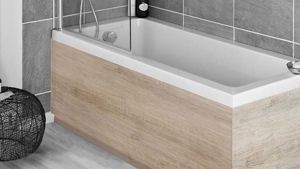Knowing how to fit a kitchen sink is an extremely useful skill to have and will save you a significant amount of plumber costs whenever you purchase a new sink and taps to go with it. In this article we take you through a very simple and informative step-by-step guide on removing and replacing a sink.
In This Article:
How To Remove A Kitchen Sink
You will need:
- Adjustable wrenches
- Pliers
- Screwdriver
- Stanley knife or similar
- Small bucket
- Old towel
Before you remove your kitchen sink, take a picture of your plumbing setup below the sink before you rip out your old unit, both for your reference and that of a plumber in case the unthinkable occurs!
1. Turn Off The Water
First, turn off the water supply lines. You will most likely locate the shut off valves in the cabinet below the sink, yet can just turn off your home’s main water line if you cannot find them.
Now turn on your kitchen sink taps to relieve the water lines of any remaining water pressure.
2. Disconnect The Water Supply Lines
Next, disconnect the water supply lines to your taps with your adjustable wrenches. Prepare your small bucket below the lines as an amount of water will inevitably remain in the lines.
3. Disconnect The Drainpipe
Use pliers to safely disconnect the drainpipe as well as any food disposal units and dishwasher drainlines. Check the manufacturer’s directions when disconnecting specialist units such as these to avoid damaging them. You can also keep an old towel handy to soak up any spillage that occurs.

4. Loosen The Metal Clips
Now use a screwdriver to loosen the metal clips connecting your kitchen sink to the underside of your counter. When done, rotate them in toward the centre of your kitchen sink for smooth removal.
5. Cut The Sealant
Next, take your Stanley knife or similar cutting utensil and run it around the sealant on the top side of the counter, breaking the seal between counter and sink.
6. Remove Your Sink
With everything safely disconnected and the connecting clips pushed in, you can now push up from the underside of your kitchen sink and remove the old unit.
With the area cleared, use a putty knife or flat metal tool to clear all remaining sealant and grime from the rim of the counter top cut out.
TIP: If you are replacing your taps then do not bother removing them from your sink. Simply remove the unit as one.
Preparing To Remove & Install a Kitchen Sink
While it may not be the biggest endeavour in the DIY handbook, installing a kitchen sink is by no means the smallest, and an amount of preparation will be more than worth it when it comes to launching on the task at hand.
Assuming that we are replacing an existing sink with an existing cut out in the worktop, you will need to select a kitchen sink that is proportioned appropriately for a straight switch.
Of course, if you have a differently sized kitchen sink in mind then you will need to either cut an extra portion out of your counter top or install a new stretch of counter top.
Cutting Your Countertop To Fit Your Sink
You will need a:
- Pencil
- Power saw
- Jigsaw
- Drill (+10/15mm drill bits)
- File or sandpaper
- Waterproof sealant
1. Mark Out Your Sink On The Worktop
Place your new kitchen sink upside down on the underside of the counter and outline it in pencil. It is important to ensure the counter is flipped so that you do not mark the counter top’s actual surface.
Now move the sink out of the way and add its manufacturer’s recommended extra depth (usually 10mm) inside of the first line you drew.

2. Drill Holes Using Your Markings
Use your drill to make four holes in the corners of the inner lining you have drawn.
3. Cut Out The Worktop
Using your jigsaw, carefully cut along the inner line. Ensure that you have properly supported the area of worktop so that it does not collapse mid-cutting.
4. Smooth Down The Edges
Smooth down the edges of your counter top cut out with your file or sandpaper then coat the inner rim with waterproof sealant and leave to cure.
Bear in mind that this approach will work fine for all wood and laminate counter tops yet a granite or stone counter will likely require specialist help (unless you have the tools and experience to confidently cut such a counter top).
How To Fit A Kitchen Sink
- Attach the clips
- Fit your taps
- Fit the strainer
- Add sealant to the underside
- Lower your sink into the worktop cutout
- Tighten up the metal clips
- Connect the water supply
- Add sealant

You will need:
- Plumber’s putty
- Silicone sealant
- Screwdriver
- Pliers
- Adjustable wrench
First, size up your new kitchen sink against your counter top cut out. If you have done your measurements properly then the replacement should fit just fine. If it does not, then head up to our cutting your countertop step.
Step 1: Attach The Clips
First, attach the clips to the underside of the kitchen sink and fold them in toward the sink bowl.
Step 2: Fit Your Taps
Next, take the taps from the previous sink or gather our new taps and slot them into the corresponding holes atop the sink, ensuring you follow the manufacturer’s guide on all present spacers and O-rings.
If you have a mixer tap then you will only need one tap hole in your new kitchen sink. If you have a hot and cold tap then you will require two sink holes.
 Step 3: Fit The Strainer
Step 3: Fit The Strainer
Take your drain strainer and apply a small consistent ring of plumber’s putty around the underside of its lip. Screw it in tightly, ensuring a smooth fit with the putty.
Lean the kitchen sink on its side and apply the rubber gaskets and threaded flange to the underside of the drain strainers. Cross-reference your work with the manufacturer’s instructions to ensure proper installation order of these components. Then wipe away any excess with an old towel.
If you are reconnecting a food disposal unit and other specialist units, follow the manufacturer’s instructions and reconnect the brackets to the bottom of your new sink in the correct manner.
Step 4: Add Sealant To Your Sink
With all of your sink equipment connected to your new kitchen sink, run a bead of silicone sealant around the underside of the edge of the sink.
Step 5: Lower Your Sink Into The Worktop Cutout
Carefully lower the sink into your counter top cut out ensuring that you set the unit squarely.

Step 6: Tighten Up The Metal Clips
Time to dive back under and flip those metal clips outward then get out the trusty screwdriver and tighten them up against the underside of the counter top, locking your new kitchen sink into place.
Step 7: Connect The Water Supply
With the kitchen sink secured, take your adjustable wrenches and connect your tap lines back to your home’s water supply lines. Be extremely careful when attaching these that the threads are lined up so as not to strip the threads.
Reconnect your food disposal units and other specialist connections such as dishwasher drain in line with the manufacturer’s instructions. Then reconnect the drainline with your pliers.
Reconnect all power to your specialist connections such as food disposal units, then it is time to turn back on your water supply.
You can’t relax just yet – first, we must run the system and check for leaks.
Step 8: Add Sealant
If you are sure everything is connected correctly and there are no leaks, you can run a bead of sealant around the top edge of the sink to create a waterproof seal. Remember to allow this to cure properly before using your sink.
Troubleshooting
If you run into any problems when installing your sink, take a look at these common issues:
Modifying Drainpipe Sizing
While you have taken every precaution to ensure your kitchen sink dimensions align with those of your old sink, you may not be so lucky when it comes to the length of your drainpipes. Hey – no good DIY job is without its unexpected challenges, right?
If your old drainpipes don’t line up, we can easily adjust them so that they do.
If a pipe is too long:
- Measure the length to be cut off, then subtract 10mm or so to ensure a tight fit.
- Cut the piece of pipe with a hacksaw.
- Place a washer over the pipe then a slip nut over the washer.
- If a slip nut is required for the other end of the pipe, place one on in reverse then perform the previous step so that you have one at each end of the pipe.
- Hold the pipe in place and screw the slip nuts in appropriately.
If a pipe is too short:
- Measure the length that must be added.
- Head to your local DIY store and buy a suitable pipe, ensuring the correct diameter.
- Use a hacksaw to cut the pipe down to the exact size required. Add 10mm or so to ensure a tight fit.
- Place a washer over the pipe then a slip nut over the washer.
- If a slip nut is required for the other end of the pipe, place one on in reverse then perform the previous step so that you have one at each end of the pipe.
- Hold the pipe in place and screw the slip nuts in appropriately.
Leaks
If you do encounter any leaks then they should be simple to locate. Once located, turn off the water and readjust then run the system once more. If you cannot locate them or have sprung a serious leak, it may be time to call your friendly local plumber.
If everything has gone according to plan, you should now have a stylish new sink in your kitchen. If you haven't yet selected your new sink, take a look at the great range available at Tap Warehouse.









